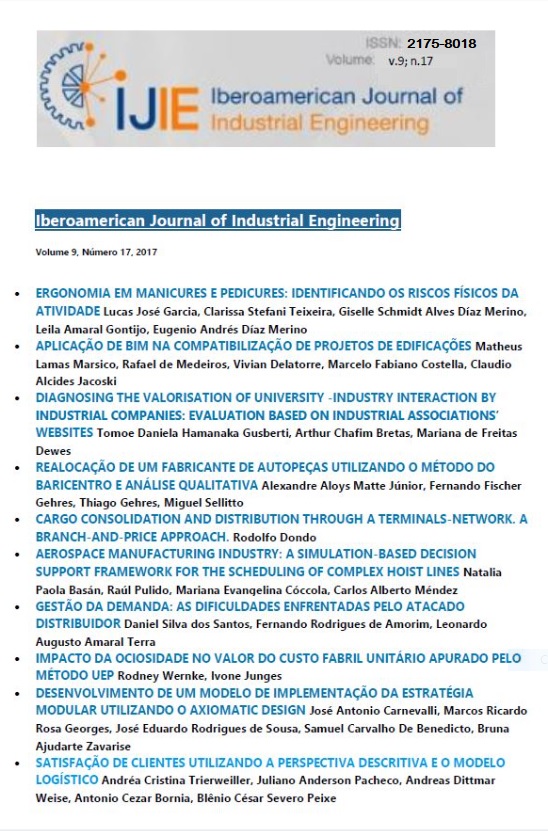DIAGNOSING THE VALORISATION OF UNIVERSITY -INDUSTRY INTERACTION BY INDUSTRIAL COMPANIES: EVALUATION BASED ON INDUSTRIAL ASSOCIATIONS’ WEBSITES
Palavras-chave:
university, dynamic industries, industrial association, technology transfer, business incubationResumo
This work aims to identify ways to which companies and universities relate to each other and the importance attributed by companies to this kind of interaction. Specifically, it seeks to understand the degree to which university-industry interaction is approached, comparing Brazilian industry to that of so-called developed countries. We use a qualitative and exploratory approach, specifically content analysis (Bazeley & Jackson, 2013; Krippendorff, 2003), and industrial associations’ websites as a data source. Results indicate that there is emerging conscience in Brazilian strategic industries about universities as a source of useful technology, but not about the role of university spin-off generation as an important element for technological and industrial development. Participation of Universities as members of industrial associations appears to be similar to benchmark associations. The promotion of university-industry interaction as core mission is uncommon either in benchmark associations nor Brazilian associations, but Benchmark associations, in more dynamic industries always mention universities as a source of technological service (by various technology transfer mechanisms), a situation which was not observed in the Brazilian reality. Hence, data shows that the connection between Universities and Brazilian universities has yet to be improved. The results also suggest that Brazilian Medical Industry Complex, Industrial Chemistry, Electronics, Materials, and Information Technology present less conscience and valuation of University as a potential source of innovation, in comparison to the international benchmark.
Referências
Arora, A., Fosfuri, A., & Gambardella, A. (2001). Specialized technology suppliers , international spillovers and investment : evidence from the chemical industry, 65.
Bazeley, P., & Jackson, K. (2013). Qualitative Data Analysis with NVIVO (Second Edi). London: Sage Publications Ltd.
Bell, M., & Pavitt, K. (1997). Technological accumulation and industrial growth: contrasts between developed and developing countries. Technology, Globalisation and Economic …, 2(2), 157–210.
Bennett, R. J., & Robson, P. J. a. (2001). Exploring the market potential and bundling of business association services.
BioStorage Technologies. (2016). Top Trends in R&D Outsourcing Impacting Future R&D Success? Retrieved September 1, 2016, from http://www.biostorage.com/blog?posts/top?trends?in?rd?outsourcing?impacting?future?rd?success/
Carraz, R., Nakayama, I., & Harayama, Y. (2014). Openness, open innovation à la Chesbrough and intellectual property rights. In T. Madiès, D. Guellec, & J. C. Prager (Eds.), Patent markets in the global knowledge economy theory, empirics and public policy implications: Theory, Empirics and Public PolicyImplications (pp. 209–234). Cambridge: Cambridge University Press.
Chesbrough, H., Vanhaverbeke, W., & West, J. (2006). Open Innovation: Researching a New Paradigm, 400.
Etzkowitz, H., De Mello, J. M. C., & Almeida, M. (2005). Towards “meta-innovation†in Brazil: The evolution of the incubator and the emergence of a triple helix. Research Policy, 34(4), 411–424.
Etzkowitz, H., & Leydesdorff, L. (2000). The dynamics of innovation : from National Systems and “‘ Mode 2 ’†to a Triple Helix of university – industry – government relations, 109–123.
Hoppe, H. C., & Ozdenoren, E. (2005). Intermediation in innovation. International Journal of Industrial Organization, 23(5–6), 483–503.
Howells, J. (1999). Research and Technology Outsourcing. Technology Analysis & Strategic Management, 11(1), 17–29.
Knockaert, M., Spithoven, A., & Clarysse, B. (2014). The impact of technology intermediaries on firm cognitive capacity additionality. Technological Forecasting and Social Change, 81(1), 376–387.
Krippendorff, K. (2003). Content Analysis: An Introduction to Its Methodology. SAGE.
Leitner, K. H. (2005). Managing and reporting intangible assets in research technology organisations. R and D Management, 35(2), 125–136.
Lundvall, B.-Ã…. (1988). Innovation as an interactive process: from user-supplier interaction to the national system of innovation. In L. DOSI, G. FREEMAN, C., NELSON, R., SILVERBERG, G., SOETE (Ed.), Technical Change and Economic Theory.
Lundvall, B.-Å. (2007). National Innovation Systems—Analytical Concept and Development Tool. Industry & Innovation, 14(1), 95–119.
Pénin, J. (2008). More open than open innovation ? Rethinking the concept of openness in innovation studies. Working Papers of BETA, n°150(33), 89–111.
Pénin, J. (2011). Open source innovation: Towards a generalization of the open source model beyond software. Revue D’économie Industrielle, 136(4éme trimestre), 65–88.
PwC. (2013). R&D outsourcing in hi-tech industries: A research study. Pwc (Vol. 4).
Shane, S. A. (2004). Academic Entrepreneurship: University Spinoffs and Wealth Creation. Edward Elgar Publishing.
Teece, D. J. (1998). Capturing value from knowledge assets: The new economy, markets for know-how, and intangible assets. California Management Review, 40(3), 55–80.
Downloads
Publicado
Como Citar
Edição
Seção
Licença
Os artigos publicados são de propriedade do IJIE – Iberoamerican Journal of Industrial Engineering, Revista Iberoamericana de Engenharia Industrial, Revista Iberoamericana de Ingeniería Industrial. Os autores são os responsáveis pelos conteúdos dos artigos. O IJIE não se responsabiliza ou endossa as opiniões emitidas pelos autores dos textos publicados, salientando que as opiniões são de exclusiva responsabilidade dos autores.
O periódico se reserva o direito de introduzir alterações no original, visando a manter a homogeneidade e a qualidade da publicação, respeitando, no entanto, o estilo e as opiniões dos autores. Essas alterações serão editoriais (correções gramaticais e adequações estilísticas) e não substanciais, de forma que não modifiquem o sentido do texto. As provas finais não serão enviadas aos autores, sendo o artigo publicado com os ajustes necessários.
Conforme citado neste site, no item “Caráter do IJIE”, os artigos são de uso gratuito, com atribuições próprias em aplicações educacionais e não-comerciais. Uma nova publicação do mesmo texto, de iniciativa de seu autor ou de terceiros, fica sujeita à expressa menção da precedência de sua publicação neste periódico, citando-se a edição e a data dessa publicação.

